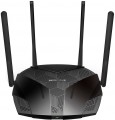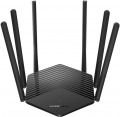Wi-Fi standards
Wi-Fi standards supported by the equipment. Nowadays, in addition to modern standards
Wi-Fi 4 (802.11n),
Wi-Fi 5 (802.11ac),
Wi-Fi 6 (802.11ax)(its variation
Wi-Fi 6E),
Wi-Fi 7 (802.11be) and
WiGig (802.11ad), you can meet also support for earlier versions —
Wi-Fi 3 (802.11g) and even Wi-Fi 1 (802.11b). Here is a more detailed description of each of these versions:
— Wi-Fi 3 (802.11g). An outdated standard, like Wi-Fi 1 (802.11b), which has sunk into oblivion. It was widely used before the advent of Wi-Fi 4, nowadays it is used mainly as an addition to newer versions — in particular, in order to ensure compatibility with outdated and low-cost equipment. Operates at a frequency of 2.4 GHz, the maximum data transfer rate is 54 Mbps.
— Wi-Fi 4 (802.11n). The first of the common standards that supports the frequency of 5 GHz; can operate in this range or in the classic 2.4 GHz. It is worth emphasizing that some models of Wi-Fi equipment for this standard use only 5 GHz, which is why they are incompatible with earlier versions of Wi-Fi. The maximum speed for Wi-Fi 4 is 600 Mbps; in modern wireless devices, this standard is very popular, only recently it began to be squeezed into this position by Wi-Fi 5.
— Wi-Fi 5
...(802.11ac). The successor to Wi-Fi 4, which finally moved to the 5 GHz band, which had a positive effect on the reliability of the connection and data transfer rate: it is up to 1.69 Gbps per antenna and up to 6.77 Gbps in general. In addition, this is the first version to fully implement Beamforming technology (for more details, see "Functions and Capabilities").
— Wi-Fi 6, Wi-Fi 6E (802.11ax). The development of Wi-Fi 5, which introduced both an increase in speed to 10 Gbps, and a number of important improvements in the format of work. One of the most important innovations is the use of an extensive frequency range — from 1 to 7 GHz; this, in particular, allows you to automatically select the least loaded frequency band, which has a positive effect on the speed and reliability of the connection. At the same time, Wi-Fi 6 devices are capable of operating at classic frequencies of 2.4 GHz and 5 GHz, and a modification of the Wi-Fi 6E standard is capable of operating at frequencies from 5.9 to 7 GHz, it is generally accepted that devices with Wi-Fi 6E support operate on frequency of 6 GHz, while there is full compatibility with earlier standards. In addition, some improvements were introduced in this version regarding the simultaneous operation of several devices on one channel, in particular, we are talking about OFDMA technology. Thanks to this, Wi-Fi 6 gives the smallest of modern standards a drop in speed when the air is loaded, and the modification of Wi-Fi 6E operating at a frequency of 6 GHz has the least amount of interference.
— Wi-Fi 7 (802.11be). This Wi-Fi standard began to be implemented in 2023. Thanks to the use of 4096-QAM modulation, a maximum theoretical data rate of up to 46 Gb / s can be squeezed out of it. Wi-Fi 7 supports three frequency bands: 2.4 GHz, 5 GHz and 6 GHz. The maximum bandwidth in the standard has been increased from 160 MHz to 320 MHz - the wider the channel, the more data it can transmit overnight. Among the interesting innovations in Wi-Fi 7, the development of MLO (Multi-Link Operation) is noted - with its help, connected devices exchange data using several channels and frequency bands simultaneously, which is especially important for VR and online games. The Multiple Resource Unit technology is designed to minimize communication delays when there are many connected client devices. The new 16x16 MIMO protocol is also aimed at increasing throughput with a large number of simultaneous connections, doubling the number of spatial streams compared to the previous Wi-Fi 6 standard.
WiGig (802.11ad). Wi-Fi standard using an operating frequency of 60 GHz; data transfer rates can be up to 10 Gbps (depending on the specific version of WiGig). The 60 GHz channel is much less loaded than the more popular 2.4 GHz and 5 GHz, which has a positive effect on the reliability of data transmission and reduces latency; the latter is especially important in games and some other special tasks. On the other hand, the increase in frequency has significantly reduced the connection range (for more details, see "Frequency range"), so that in fact this standard is only suitable for communication within the same room.
Note that in fact, the data transfer rate is usually much lower than the theoretical maximum — especially when several Wi-Fi devices operate on the same channel. Also note that different standards are backwards compatible with each other (with a speed limit according to the slower one) provided that the frequencies match: for example, 802.11ac can work with 802.11n, but not with 802.11g.Wireless speed 2.4 GHz
The maximum speed provided by the device when communicating wirelessly in the 2.4 GHz band.
This range is used in most modern Wi-Fi standards (see above) - as one of the available or even the only one. The theoretical maximum for it is 600 Mbit. In reality, Wi-Fi at a frequency of 2.4 GHz is used by a large number of client devices, from which congestion of data transmission channels emerges. Also, the number of antennas affects the speed performance of the equipment. It is possible to achieve the speed declared in the specification only in an ideal situation. In practice, it can be noticeably smaller (often by several times), especially with an abundance of wireless technology simultaneously connected to the equipment. The maximum speed at 2.4 GHz is specified in the characteristics of specific models to understand the real capabilities of Wi-Fi equipment. As for the numbers, according to the capabilities in the 2.4 GHz band, modern equipment is conditionally divided into models with speeds
up to 500 Mbit inclusive and
over 500 Mbit.
Wireless speed 5 GHz
The maximum speed supported by the device when communicating wirelessly in the 5 GHz band.
This range is used in Wi-Fi 4, Wi-Fi 6 and Wi-Fi 6E as one of the available bands, in Wi-Fi 5 as the only one (see "Wi-Fi Standards"). The maximum speed is specified in the specifications in order to indicate the real capabilities of specific equipment - they can be noticeably more modest than the general capabilities of the standard. Also, in fact, it all depends on the generation of Wi-Fi. For example, devices with Wi-Fi 5 support can theoretically deliver up to 6928 Mbit (using eight antennas), with Wi-Fi 6 support up to 9607 Mbit (using the same eight spatial streams). The maximum possible communication speed is achieved under certain conditions, and not every model of Wi-Fi equipment fully satisfies them. Specific figures are conditionally divided into several groups: the value
up to 500 Mbit is rather modest, many devices support speeds in the range of
500 - 1000 Mbit, indicators of
1 - 2 Gbps can be attributed to the average, and the most advanced models in class provide a data exchange rate of
over 2 Gbps.
LAN
In this case, LAN means standard network connectors (known as RJ-45) designed for wired connection of LAN devices — PCs, servers, additional access points, etc. The number of ports corresponds to the number of devices that can be directly connected to wired equipment. way.
In terms of speed,
100 Mbps (Fast Ethernet) and
1 Gbps (Gigabit Ethernet) are the most popular options today. At the same time, thanks to the development of technology, more and more gigabit devices are being produced, although in fact this speed is critical only when transferring large amounts of information. At the same time, some models, in addition to the standard speed of the main LAN ports, may have
a 2.5 Gbps, 5 Gbps and even 10 Gbps LAN port with increased bandwidth.
Number of antennas
The total number of antennas (of all types — see below) provided in the design of the device.
In modern Wi-Fi equipment, this indicator can be different: in addition to the simplest devices with 1 antenna, there are models where this number is
2,
3,
4 and even
more. The point of using multiple antennas is twofold. Firstly, if there are several external devices per antenna, they have to share the bandwidth among themselves, and the actual communication speed for each subscriber drops accordingly. Secondly, such a design may also be required when communicating with one external device — to work with MU-MIMO technology (see below), which allows you to fully realize the capabilities of modern Wi-Fi standards.
Anyway, more antennas, usually, means a more advanced and functional device. On the other hand, this parameter significantly affects the cost; so specifically looking for equipment with numerous antennas makes sense mainly when the speed and stability of communication are critical.
Note that antennas intended for mobile communications may also be considered in this clause. So when choosing a model with support for mobile networks, it's ok to clarify this point.
Transmitter power
Rated power of the Wi-Fi transmitter used in the device. If multiple bands are supported (see “Ranges of operation”) the power for different frequencies may be different, for such cases the maximum value is indicated here.
The total transmitting power provided by the device directly depends on this parameter. This power can be calculated by adding the transmitter power and the antenna gain (see above): for example, a 20 dBm transmitter coupled with a 5 dBi antenna results in a total power of 25 dBm (in the main antenna coverage area). For simple domestic use (for example, buying a router in a small apartment), such details are not required, but in the professional field it often becomes necessary to use wireless devices of a strictly defined power. Detailed recommendations on this matter for different situations can be found in special sources, but here we note that the total value of 26 dBm or more allows the device to be classified as equipment
with a powerful transmitter. At the same time, such capabilities are not always required in fact: excessive power can create a lot of interference both for surrounding devices and for the transmitter itself (especially in urban and other similar conditions), as well as degrade the quality of the connection with low-power electronics. And for effective communication over a long distance, both the equipment itself and external devices must have the appropriate power (which is far from alway
...s achievable). So, when choosing, you should not chase the maximum number of decibels, but take into account the recommendations for a particular case; in addition, a Wi-Fi amplifier or MESH system often turns out to be a good alternative to a powerful transmitter.Signal strength 2.4 GHz
The power of the transmitter installed in the equipment when operating in the 2.4 GHz band (see "Frequency Band").
This parameter directly affects the overall power and, accordingly, the communication efficiency. For more on this, see p. "Transmitter power" above, but here we separately emphasize that high power is not always required, and in some cases it is frankly harmful.
Signal strength 5 GHz
The power of the transmitter installed in the equipment when operating in the 5 GHz band (see "Frequency Band").
This parameter directly affects the overall power and, accordingly, the communication efficiency. For more on this, see p. "Transmitter power" above, but here we separately emphasize that high power is not always required, and in some cases it is frankly harmful.
Signal strength 6 GHz
The power of the transmitter installed in the equipment when operating in the 6 GHz band (see "Frequency Band").
This parameter directly affects the overall power and, accordingly, the communication efficiency. For more on this, see p. "Transmitter power" above, but here we separately emphasize that high power is not always required, and in some cases it is frankly harmful.

